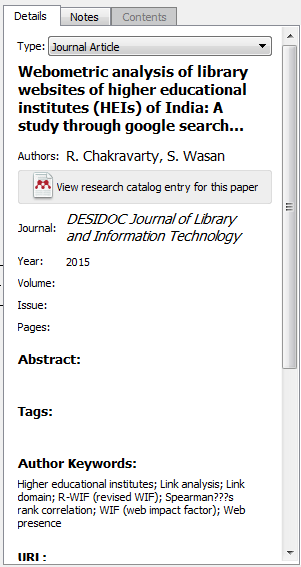

Mendeley is a free reference manager and academic social network that can help you organize your research, collaborate with others online, and discover the latest research:
The Mendeley Web Importer Import papers, web pages and other documents directly into your reference library from search engines and academic databases. Mendeley Web Importer is available for all major web browsers. Install the Web Importer to import references from different databases to Mendeley Desktop in the easiest way.

The Mendeley Desktop library is divided into 3 sections, with dropdown menus & icons along the top. Note the Sync button; click this icon to synchronize your Desktop & Web libraries.

Learn more about Mendeley's library by viewing this Mendeley Minute: http://youtu.be/VD1z0boSpQY

 ) or as Read/Not Read(
) or as Read/Not Read( ).
).


On the web, your account opens to Feed (Find relevant papers based on what you're reading) Library, Suggest, Status, Groups (find new public groups to follow or join), Data search, Careers, Funding & Library search (search papers).
Your library on Mendeley Web now looks similar to your desktop library. From Mendeley.com, selecting the library tab opens a new window.
On the left, are the folders that organize your library & your public & private groups.
In the center are your citations, your whole library or a specific folder or group that you've selected.
The icons above your library allow you to add or delete documents, folders, & groups.

PDFs from your library now open in a new window. Download the PDF using the link at the top right.
You can't add notes or highlight PDFs in your library on the web.

Find papers quickly by searching the Mendeley Research Catalogue (enter search terms in the search box), or browse papers by discipline from the list on the right. Save papers to your library with a single click (Save reference/PDF to library).

See groups that you are a member of, browse other groups by discipline, or create a new group.


Just drag one or more PDFs from a dedicated folder on your desktop, share space, or USB drive into your library into Mendeley Desktop. The program then extracts the metadata (author, title, journal name, etc.) to create a library record.
Note: Keep a folder for Mendeley PDFs on each computer that you use (it only needs to have the PDFs that were uploaded from that computer, not all PDFs in Mendeley) or keep them on share space. If the program senses that there may be errors in the record, it will be placed in a Needs Review folder until you correct the information or confirm that it is correct. Use the Search by title button to search Google Scholar, or use the research catalogue entry to correct errors.
Use the Web Importer browser extension / bookmarklet to save references to your library. Click the Mendeley icon (Showed in red circle given in the screenshot below), sign in to Mendeley & in the new window, and select the references to import. Check Download PDFs if available to have PDFs that are freely available automatically imported.

Search Mendeley's crowd-sourced research catalogue on the web for specific articles or subjects. To add references from the catalogue to your library, simply click the Save Reference to library or Save PDF to library button when the PDF is freely available to all to add both the record & the PDF as the same time.

You can transfer your library from EndNote, Papers, Zotero, Refworks, Jabref and more.

Use the File menu to 'Add Files…'. Use this option to select a specific paper from a location on your computer and add it to your Mendeley library.
Use 'Add Folder…' - also found in the File menu - to select a specific folder and to add any papers it contains to your library.

There are 2 ways to insert citations with Mendeley: working within your Word document or beginning in your Mendeley library.
Watch this video to watch an overview of how to insert citations & format citations & bibliographies using Mendeley.
Download the Word plug-in (from the Tools menu of Mendeley Desktop). Have both your Word document and your Mendeley Desktop library open. Remember, you can't insert citations from Mendeley Web. Once installed, you will have tool bar buttons that will allow you to cite a document, generate a bibliography, or manually edit any entry.
Place your cursor exactly where you want the citation to go in your Word document. On the References tab of Word, click the Insert Citation icon. The Style dropdown box will not display a bibliographic style until you have inserted your first citation.

In the search window that opens, enter a search term to bring up the citation you need. Note that you can search your whole library (My Library), which is the default setting, or, using the dropdown menu, choose from your folders or groups. Select the citation to insert & click OK.

From the Style dropdown list, choose a bibliographic style. Place your cursor exactly where you want the bibliography to appear, and then click Insert Bibliography.
You can insert a bibliography at any time after citations have been entered into your Word document. New references will continue to be added to the list.

FPlace the cursor where you want the citation to go in your Word document.
On the References tab, click the Insert Citation.
Click the Go to Mendeley button on the search box to view your complete library.

Select the citation(s) to add (use the CTRL key to select more than one citation).
Click the Send Citation to Word Processor icon.

To edit a reference, for example, to add a specific page number to an in-text citation, highlight the citation to be edited, & click the Edit Citation icon (the Add Citation icon changes to Edit Citation when you highlight an existing citation).
In the Edit Citation window that opens, highlight the citation, then make your changes (adding a page number if the output style that you're selected supports that, adding a prefix--such as "c.f."-- or a suffix--such as "emphasis added", or suppress the author.) New references will continue to be added to the list.

Organizing your library with folders is simple.
Learn more about organizing your library with folders in this Mendeley Minute:
http://youtu.be/VD1z0boSpQY
Groups in Mendeley allow users to share information with others. There are 2 types of groups.
Private Groups allows you to share documents & comments only with people you invite. This is a great tool to facilitate collaboration on projects or within classes.
Public Groups allow you to share a list of documents that can be viewed or added to by members of the group. Citations in a public group are automatically added to your library when you join; associated PDFs are not, but you can download.
You can search Mendeley on the Web for public groups on the Groups tab.


Mendeley does far more than is described in this brief summary. Abundant documentation is available at the Mendeley website. This includes a number of screen cast tutorials and information on how to: